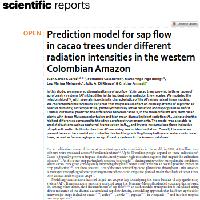Resumen
- In this study, we measured diurnal patterns of sap fow (Vs) in cacao trees growing in three types of agroforestry systems (AFs) that difer in the incident solar radiation they receive. We modeled the relationship of Vs with several microclimatic characteristics of the AFs using mixed linear models. We characterized microclimatic variables that may have an efect on diurnal patterns of sap fow: air relative humidity, air temperature, photosynthetically active radiation and vapor pressure defcit. Overall, our model predicted the diferences between cacao Vs in the three diferent AFs, with cacao plants with dense Musaceae plantation and high mean diurnal incident radiation (HPAR) displaying the highest diferences compared to the other agroforestry arrangements. The model was also able to predict situations such as nocturnal transpiration in HPAR and inverse nocturnal sap fows indicative of hydraulic redistribution in the other AFs receiving less incident radiation. Overall, the model we present here can be a useful and cost-efective tool for predicting transpiration and water use in cacao trees, as well as for managing cacao agroforestry systems in the Amazon rainforest.
